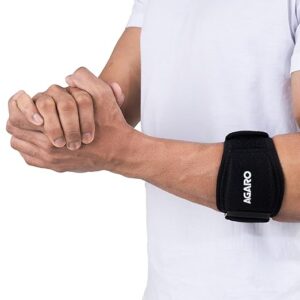Tennis Elbow: A Comprehensive Guide to Support and Relief
Introduction (Tennis Elbow: Guide to Support and Relief )
Tennis elbow, or lateral epicondylitis, is a very common overuse injury .
That affects the tendons that attach the forearm muscles to the lateral epicondyle (the bony protrusion on the outside of the elbow).
While the name might suggest that it’s a condition exclusive to tennis players, this painful affliction can impact anyone who engages in repetitive motions or activities that put excessive strain on the elbow joint.
As the tendons become inflamed, individuals may experience pain, tenderness, and discomfort around the outside of the elbow.
which can sometimes radiate down the forearm or up the arm.
This discomfort is often exacerbated by activities that involve gripping or twisting motions, such as turning a doorknob, lifting objects, or participating in sports.
While tennis elbow can be a frustrating and debilitating condition.
There are several strategies and support options available to alleviate the symptoms and promote healing.
One of the most effective solutions is to use a tennis elbow support or brace.
Understanding Tennis Elbow Supports
Function and Design
Tennis elbow supports, also known as braces or straps, are specialized devices designed to apply gentle pressure to the forearm muscles, reducing the strain on the inflamed tendons around the elbow joint.
By immobilizing the area and limiting the range of motion, these supports allow the tendons to rest and heal, while still permitting some level of activity.
These braces come in various designs, but they typically feature adjustable straps or velcro closures, allowing for a customized fit.
Some models may also incorporate additional features, such as gel pads or compression inserts, to enhance comfort and support.
Choosing the Right Support
When selecting a tennis elbow support, it’s essential to choose one that fits properly and provides adequate compression without being too tight.
A brace that is too loose may not provide sufficient support, while one that is too tight can restrict blood flow and cause discomfort.
It’s also important to consider the materials used in the construction of the brace.
Look for breathable fabrics that allow for air circulation and prevent excessive sweating, as well as durable materials that can withstand regular use and washing.
Proper Usage and Care ( Tennis Elbow: Guide to Support and Relief )
To maximize the effectiveness of a tennis elbow support, it’s crucial to wear it correctly and follow the manufacturer’s instructions.
Most braces are designed to be worn during activities that aggravate the condition, but they should be removed when at rest to allow for proper circulation.

Proper care and maintenance of the brace are also essential.
Regular cleaning and proper storage can help extend the life of the support and ensure optimal performance.
Conservative Treatment Options
While tennis elbow supports can be incredibly helpful in managing the condition, they are often used in conjunction with other conservative treatment options.
These additional strategies can further alleviate symptoms and promote healing.
Rest and Activity Modification
One of the most crucial steps in treating tennis elbow is to avoid activities that aggravate the condition and allow the affected area to rest.
This may involve taking a break from sports or activities that involve repetitive motions or excessive strain on the elbow joint.
Ice Therapy ( Tennis Elbow: Guide to Support and Relief )
Applying an ice pack to the elbow for 15-20 minutes several times a day can help reduce inflammation and pain.
Cold therapy constricts blood vessels, reducing swelling and numbing pain in the affected area.
Over-the-Counter Pain Medication
Anti-inflammatory drugs, such as ibuprofen or naproxen, can be helpful in alleviating pain and swelling associated with tennis elbow.
However, it’s essential to consult with a healthcare professional before taking any medication, especially for prolonged periods.
Physical Therapy
Working with a physical therapist can be highly beneficial in the treatment of tennis elbow.
A therapist can provide exercises and stretches to improve strength, flexibility, and range of motion in the affected area.
They may also recommend techniques such as ultrasound or electrical stimulation to promote healing and reduce pain.
Advanced Treatment Options
In some cases, conservative treatments may not provide sufficient relief, and more advanced treatment options may be necessary.
Corticosteroid Injections
If inflammation and pain persist despite conservative measures, a healthcare professional may recommend corticosteroid injections directly into the affected area.
These injections can help reduce inflammation and temporarily alleviate pain, allowing for more effective physical therapy and rehabilitation.
Surgery ( Tennis Elbow: Guide to Support and Relief )
In severe or chronic cases of tennis elbow, where conservative and injectable treatments have failed, surgery may be considered as a last resort.
Surgical procedures may involve removing damaged tissue, releasing the tendon, or even relocating the tendon attachment point to alleviate strain on the affected area.
Regenerative Therapies ( Tennis Elbow: Guide to Support and Relief )
Emerging regenerative therapies, such as platelet-rich plasma (PRP) injections or stem cell therapies, are being explored as potential treatment options for tennis elbow.
These therapies aim to stimulate the body’s natural healing processes and promote tissue regeneration in the affected area.
Prevention and Long-Term Management
While treating tennis elbow is essential, preventing its recurrence or managing it in the long term is equally important.
Here are some strategies to consider:
Strengthening Exercises
Incorporating exercises that target the forearm and wrist muscles can help improve overall strength and stability in the affected area, reducing the risk of future injury or flare-ups.
Proper Technique and Equipment
For athletes or individuals engaging in activities that involve repetitive motions, it’s crucial to maintain proper technique and use appropriate equipment.
This can help reduce the strain on the elbow joint and prevent overuse injuries.
Activity Modification
If certain activities or movements consistently aggravate tennis elbow symptoms, it may be necessary to modify or avoid those activities to prevent further injury or re-aggravation.
Regular Stretching and Warm-Up
Incorporating stretching and warm-up routines before engaging in physical activities can help improve flexibility and prepare the muscles and tendons for the demands of the activity, reducing the risk of injury.
Conclusion (Tennis Elbow: Guide to Support and Relief)
Tennis elbow can be a debilitating and frustrating condition, but with the right support and treatment strategies.
Individuals can find relief and regain full function and mobility in their affected arm.
By understanding the benefits of tennis elbow supports and incorporating them into a comprehensive treatment plan, along with other conservative and advanced options, individuals can effectively manage their symptoms and promote healing.
Remember, seeking guidance from a healthcare professional is essential for proper diagnosis and treatment recommendations tailored to your specific needs.
With patience, dedication, and the right support, overcoming tennis elbow is achievable.
